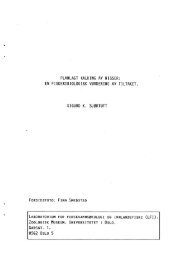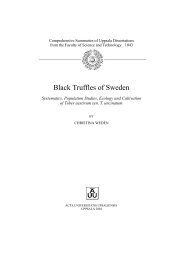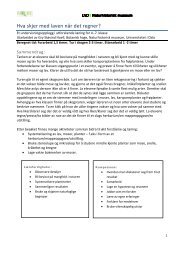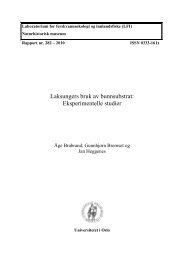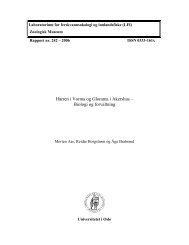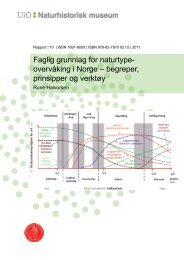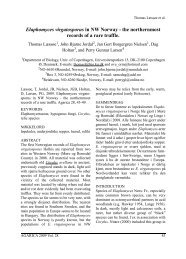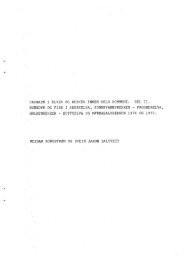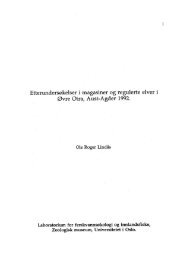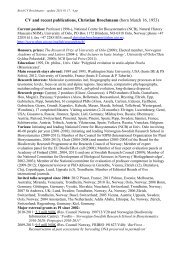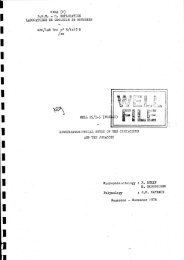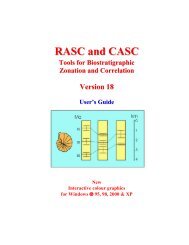Truffle trouble: what happened to the Tuberales?
Truffle trouble: what happened to the Tuberales?
Truffle trouble: what happened to the Tuberales?
- TAGS
- truffle
- www.nhm.uio.no
You also want an ePaper? Increase the reach of your titles
YUMPU automatically turns print PDFs into web optimized ePapers that Google loves.
1080 T. Læssøe, K. Hansen<br />
100<br />
100<br />
Peziza vesiculosa<br />
Peziza depressa<br />
Iodophanus carneus<br />
100 Morchella conica<br />
100 Morchella esculenta<br />
Verpa bohemica<br />
Verpa conica<br />
Disciotis venosa<br />
Fischerula subcaulis<br />
Morchellaceae<br />
100<br />
Leucangium carthusianum<br />
98 Pseudorhizina californica<br />
Discina macrospora<br />
Gyromitra melaleucoides<br />
Hydnotrya cerebriformis<br />
Discinaceae<br />
99/73 Hydnotrya cubispora<br />
Balsamia magnata<br />
91 Barssia oregonensis<br />
Underwoodia columnaris<br />
Wynnella silvicola<br />
Helvella crispa<br />
93<br />
96<br />
Helvella rivularis<br />
Helvella pezizoides<br />
Helvella aff. cupuliformis<br />
Helvella albella<br />
Helvella atra<br />
Helvella lacunosa<br />
98/78 Tuber californicum<br />
Tuber puberulum (1)<br />
Tuber puberulum (2)<br />
90 Tuber oligospermum<br />
77 Tuber borchii<br />
Tuber maculatum<br />
Tuber canaliculatum<br />
100 99<br />
Tuber gibbosum<br />
Tuber aff. gibbosum<br />
Tuber rufum var. rufum<br />
Tuber melanosporum<br />
100<br />
84<br />
95<br />
Tuber excavatum<br />
Dingleya verrucosa<br />
Reddellomyces donkii<br />
Labyrinthomyces varius<br />
Choiromyces venosus<br />
Choiromyces alveolatus<br />
Rhizina undulata<br />
Caloscypha fulgens<br />
100/97<br />
100<br />
100<br />
100<br />
*<br />
*<br />
*<br />
100/89<br />
98<br />
100<br />
100<br />
100/70<br />
Rhizinaceae<br />
Caloscyphaceae<br />
significant support). Kaliharituber is suggested as closely related<br />
<strong>to</strong> Iodowynnea (PB 75 %). The truffle genera Cazia, Ruhlandiella,<br />
Terfezia, and Tirmania, and two truffle species of Peziza,<br />
P. ellipsospora and P. whitei, are resolved among apo<strong>the</strong>ciaforming<br />
Peziza species in <strong>the</strong> P. depressa–Ruhlandiella lineage.<br />
This lineage, excluding Ruhlandiella, is supported by 100 %<br />
PP, but is with only 53 % PB.<br />
At least nine independent origins of hypogeous forms are<br />
supported by <strong>the</strong> LSU gene trees (Fig 2). Constrained MP and<br />
ML analyses forcing <strong>the</strong> two species of Hydnotryopsis <strong>to</strong> be<br />
monophyletic could not be rejected (Table 1). Likewise, forced<br />
monophyly of <strong>the</strong> hypogeous taxa within <strong>the</strong> P. depressa–<br />
Ruhlandiella lineage (not including Eremiomyces), did not yield<br />
trees that were significantly longer than <strong>the</strong> unconstrained<br />
MP trees. However, under this constraint <strong>the</strong> ML tree was<br />
significantly worse than <strong>the</strong> unconstrained optimal ML tree<br />
(Table 1). Trees rejected by MP and ML include <strong>the</strong> following<br />
monophyly constraints: truffles in <strong>the</strong> P. depressa lineage<br />
Helvellaceae<br />
Tuberaceae<br />
infolded or chambered<br />
ptyco<strong>the</strong>cium<br />
solid ptyco<strong>the</strong>cium<br />
stereo<strong>the</strong>cia<br />
10 changes<br />
Fig 3 – Phylogenetic relationships among epigeous and hypogeous taxa within <strong>the</strong> families Morchellaceae, Discinaceae,<br />
Helvellaceae and Tuberaceae (lineage B), derived from parsimony analyses of LSU rDNA sequences. One of three most<br />
parsimonious trees. Terminal taxa represent individual specimens (primarily from O’Donnell et al. 1997). Peziza vesiculosa,<br />
P. depressa and Iodophanus carneus were used <strong>to</strong> root <strong>the</strong> phylogeny. Hypogeous lineages are shown in bold. Numbers<br />
above branches represent PP ( 95 %). Numbers below branches represent PB support ( 70 %). Symbols by taxon names<br />
indicate specific fruiting body types of truffles.<br />
including Eremiomyces (with or without Ruhlandiella), Amylascus–Pachyphloeus,<br />
Pachyphloeus, Mattirolomyces with Terfezia,<br />
and Kaliharituber with Terfezia (Table 1). The most conservative<br />
conclusion is thus, that forcible spore discharge has been<br />
lost only once within each of <strong>the</strong> lineages Sarcosphaera–<br />
Hydnotryopsis and P. depressa–Ruhlandiella, once in Eremiomyces,<br />
Kaliharituber, Mattirolomyces, and Amylascus, and three times in<br />
Pachyphloeus (assuming that active spore discharge, once lost,<br />
can not be regained).<br />
Phylogenetic relationships of truffles within lineage B<br />
Parsimony analyses of lineage B yielded three equally MPTs<br />
(1235 steps, CI ¼ 0.423, RI ¼ 0.639) produced from 699 characters,<br />
of which 233 were parsimony informative. The strict consensus<br />
tree of <strong>the</strong> three MPTs is highly resolved, but support<br />
for <strong>the</strong> families are lacking, except for Tuberaceae (PB 84 %,<br />
PP 100 %, Fig 3). The trees recovered by MP, Bayesian, and



